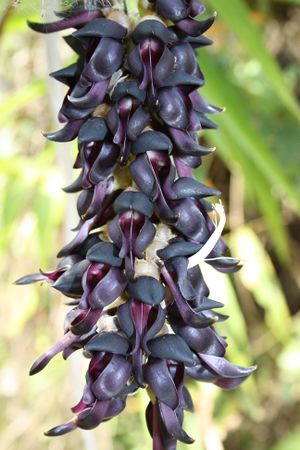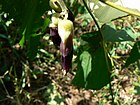Note: This is a project under development. The articles on this wiki are just being initiated and broadly incomplete. You can Help creating new pages.
Mucuna pruriens - Kapikachchu
Kapikachuchu is a tropical legume native to Africa and tropical Asia and widely naturalized and cultivated. The plant is notorious for the extreme itchiness it produces on contact, particularly with the young foliage and the seed pods.
Contents
- 1 Uses
- 2 Parts Used
- 3 Chemical Composition
- 4 Common names
- 5 Properties
- 6 Habit
- 7 Identification
- 8 List of Ayurvedic medicine in which the herb is used
- 9 Where to get the saplings
- 10 Mode of Propagation
- 11 How to plant/cultivate
- 12 Commonly seen growing in areas
- 13 Photo Gallery
- 14 References
- 15 External Links
Uses
Nervous system problems, Stress, Parkinson’s disease, Brain disease, Prolactin levels, Male Infertility, Diarrhoea, Sore throats, Piles, Swelling, Worms[1].
Food
Mucuna pruriens can be used in Food. Leaves and seeds are cooked as vegetable.[2]
Parts Used
Chemical Composition
There are many ingredients in mucuna pruriens, while L-dopa is the main content that we care about. Mature seeds contain typically 3.1-6.1% Levodopa, although up to 12.5% has been recorded. The leaves tend to contain around 0.5%.[3]
Common names
| Language | Common name |
|---|---|
| Kannada | Nayisonanguballi, Kadavare, Nayisonku balli |
| Hindi | Kewanch |
| Malayalam | Naicorna |
| Tamil | Punaippidukkan |
| Telugu | Pilliadugu |
| Marathi | NA |
| Gujarathi | NA |
| Punjabi | NA |
| Kashmiri | NA |
| Sanskrit | Atmagupta |
| English | Velvet bean, Cowitch |
Properties
Reference: Dravya - Substance, Rasa - Taste, Guna - Qualities, Veerya - Potency, Vipaka - Post-digesion effect, Karma - Pharmacological activity, Prabhava - Therepeutics.
Dravya
Rasa
Tikta (Bitter), Kashaya (Astringent)
Guna
Laghu (Light), Ruksha (Dry), Tikshna (Sharp)
Veerya
Ushna (Hot)
Vipaka
Katu (Pungent)
Karma
Kapha, Vata
Prabhava
Nutritional components
Mucuna pruriens Contains the Following nutritional components like - Vitamin- A, Thiamine (B1), Riboflavin (B2), Niacin (B3), Pantothenic acid (B5), B6 and C; Calcium, Iron, Magnesium, Manganese, Phosphorus, Potassium, Sodium, Zinc[2]
Habit
Identification
Leaf
| Kind | Shape | Feature |
|---|---|---|
| Simple | Trifoliate | Lateral leaflets conspicuously asymmetrical, 7–15 cm long, 5–12 cm wide, terminal leaflet symmetrical, somewhat smaller |
Flower
| Type | Size | Color and composition | Stamen | More information |
|---|---|---|---|---|
| Unisexual | 4–13 cm long | Purple or white | 5 | Usually more or less S-shaped, finely pubescent with white to light brown hairs. Flowering from September to November |
Fruit
| Type | Size | Mass | Appearance | Seeds | More information |
|---|---|---|---|---|---|
| Simple | 7–10 mm | Clearly grooved lengthwise, Lowest hooked hairs aligned towards crown | 100-seed | {{{6}}} |
Other features
List of Ayurvedic medicine in which the herb is used
Mushalyadi churna, Iksurahdi lehyam, Mashabaladi kashaya, Amritaprasha ghrita, Confido, Jariforte, Tentex Forte, Mentat, Vigorex[5]
Where to get the saplings
Mode of Propagation
How to plant/cultivate
Mucuna is a popular kharif crop in India. Seeds are sown at rate of 50 kg/ha between 15 June to 15th July with plant spacing of 60 × 60 cm. Delayed sowing may result in infestation of aphids (Aphis craccivora) (Oudhia 2001a )[6]. Mucuna pruriens is available through August to January[2].
Commonly seen growing in areas
Tall grasslands, Meadows, Borders of forests and fields.
Photo Gallery
References
- ↑ 1.0 1.1 1.2 ”Karnataka Medicinal Plants Volume-3” by Dr.M. R. Gurudeva, Page No.629, Published by Divyachandra Prakashana, #6/7, Kaalika Soudha, Balepete cross, Bengaluru
- ↑ 2.0 2.1 2.2 "Forest food for Northern region of Western Ghats" by Dr. Mandar N. Datar and Dr. Anuradha S. Upadhye, Page No.91, Published by Maharashtra Association for the Cultivation of Science (MACS) Agharkar Research Institute, Gopal Ganesh Agarkar Road, Pune
- ↑ Chemical Constituents
- ↑ Morphology
- ↑ Ayurvedic preparations
- ↑ Cultivation
External Links
- Ayurvedic Herbs known to be helpful to treat Nervous system problems
- Ayurvedic Herbs known to be helpful to treat Stress
- Ayurvedic Herbs known to be helpful to treat Parkinson’s disease
- Ayurvedic Herbs known to be helpful to treat Brain disease
- Ayurvedic Herbs known to be helpful to treat Prolactin levels
- Ayurvedic Herbs known to be helpful to treat Male Infertility
- Ayurvedic Herbs known to be helpful to treat Diarrhoea
- Ayurvedic Herbs known to be helpful to treat Sore throats
- Ayurvedic Herbs known to be helpful to treat Piles
- Ayurvedic Herbs known to be helpful to treat Swelling
- Ayurvedic Herbs known to be helpful to treat Worms
- Herbs with Root used in medicine
- Herbs with Leaf used in medicine
- Herbs with Seed used in medicine
- Herbs with common name in Kannada
- Herbs with common name in Hindi
- Herbs with common name in Malayalam
- Herbs with common name in Tamil
- Herbs with common name in Telugu
- Herbs with common name in Sanskrit
- Herbs with common name in English
- Habit - Herb
- Index of Plants which can be propagated by Seeds
- Index of Plants which can be propagated by Cuttings
- Herbs that are commonly seen in the region of Tall grasslands
- Herbs that are commonly seen in the region of Meadows
- Herbs that are commonly seen in the region of Borders of forests and fields
- Herbs
- Fabaceae






